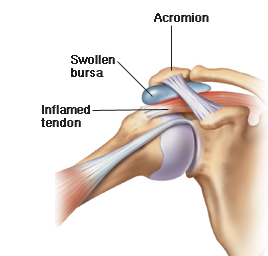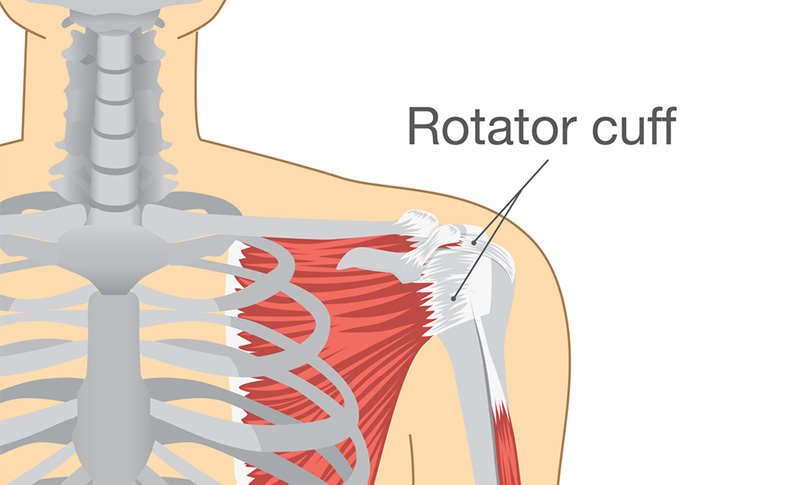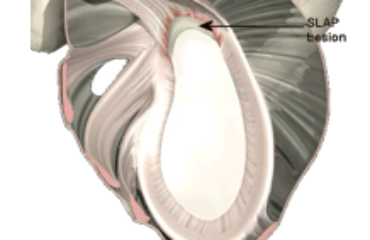The shoulder joint is a ball and socket joint that connects the humerus (upper arm bone) to the clavicle (collarbone) and the scapula (shoulder blade). The deltoid raises the arm to the level of the shoulder and slightly above. The rotator cuff muscles (supraspinatus, infraspinatus, teres minor, subscapularis)  stabilize the humeral head, preventing it from moving around too much and keeping it centered in the shoulder socket. The two muscles exert opposite, or antagonistic, effects.
stabilize the humeral head, preventing it from moving around too much and keeping it centered in the shoulder socket. The two muscles exert opposite, or antagonistic, effects.
When there is an imbalance between the two antagonists, particularly when the deltoid overpowers the rotator cuff muscles, the humeral head does not remain within a stable center location, but moves upward with the deltoid.
The humeral head now “impinges” on the rotator cuff tendon and the bursa (surrounding tissues and joint space), pinching it against the acromion, a bony part of the clavicle. The impingement causes progressive damage to the tendon and bursa, eventually leading to swelling and pain. This is referred to as impingement syndrome.
While the initial treatment is always conservative and medical, this can progress to the point of requiring surgery around 5-10% of the time. Here are the top 5 ways that you can avoid surgery for impingement syndrome of the shoulder:
1. Rest
Overuse is one of the most common causes of shoulder impingement syndrome. In the early stages, it  would be better to let the joint rest every now and then. Placing ice intermittently can ease the pain and reduce the inflammation. You may also be advised to avoid certain physical activities or motions that aggravate your injury.
would be better to let the joint rest every now and then. Placing ice intermittently can ease the pain and reduce the inflammation. You may also be advised to avoid certain physical activities or motions that aggravate your injury.
2. NSAIDs
Oral medications such as naproxen or ibuprofen are non-steroidal anti-inflammatory drugs (NSAIDs) that will reduce the symptoms of pain and inflammation. This form of therapy is the most commonly prescribed treatment for impingement syndrome.
You may be placed on NSAIDs for six to eight weeks, and improvement can usually be seen within a few days. Be sure to talk to your Phoenix sports medicine doctor about things to watch out for (such as stomach pain) during NSAID therapy.
3. Physical Therapy
Physical therapy and rehabilitation can provide balance and develop muscle strength and stability. Strengthening the rotator cuff muscles will improve the alignment of the shoulder joint and reduce the symptoms.
4. Stretching
Stretching has been shown to relieve pain in shoulder impingement syndrome. Specific stretching  exercises can not only improve symptoms, but also improve flexibility and reduce the tightness of the joints. These exercises can also be used to improve the range of motion of the joint.
exercises can not only improve symptoms, but also improve flexibility and reduce the tightness of the joints. These exercises can also be used to improve the range of motion of the joint.
5. Injections with either Steroid, PRP Therapy or Stem Cell Injections
If the conservative methods do not improve your condition, you may want to consider the injection of cortisone into the affected joint. This has been proven to be a powerful anti-inflammatory steroid, and can relieve the symptoms of pain.


